Rocky Tombs - Ancient Burials - Historical Past Of Turkey
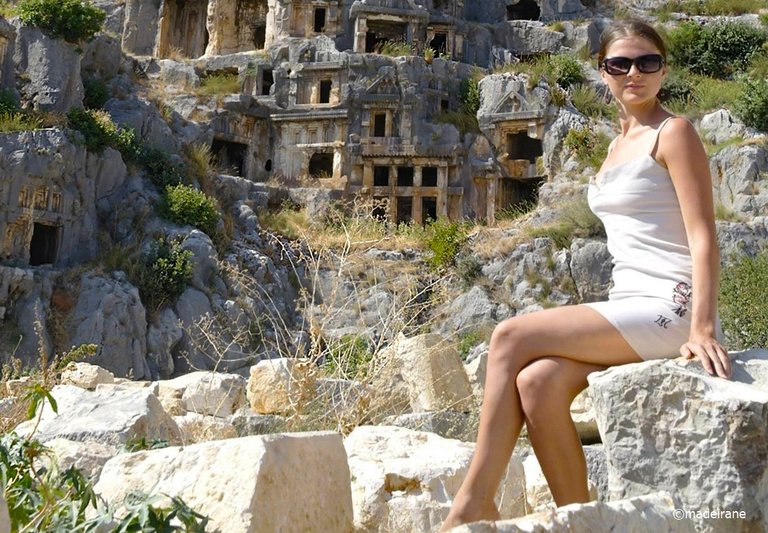
It often happens that during our travels we visit many different places, we buy some excursions, get acquainted with local attractions, buy souvenirs. But is it so often that what we pay for is worth it? How long do these tourist paths and vivid impressions remain in our memory? But today I would like to tell you about one place which I still do not regret visiting, and the memories of what I saw there are still before my eyes. So, I continue my blogs about the triple excursion Demre-Mira-Kekova.
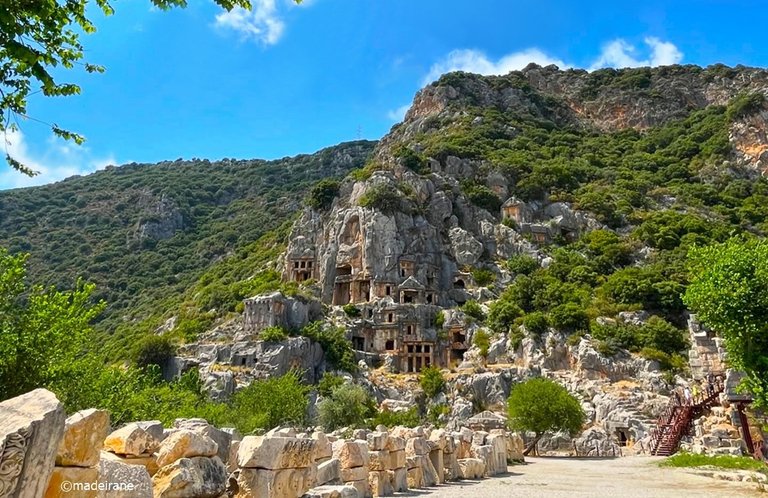
In fact, in the ancient city of Myra, there are only two objects here that are worth attention and for which everyone comes here. The first one is the amphitheater about which I already wrote a blog, and the second one is certainly something! It really leaves an indelible impression. This is an ancient necropolis, the Lycian tombs.
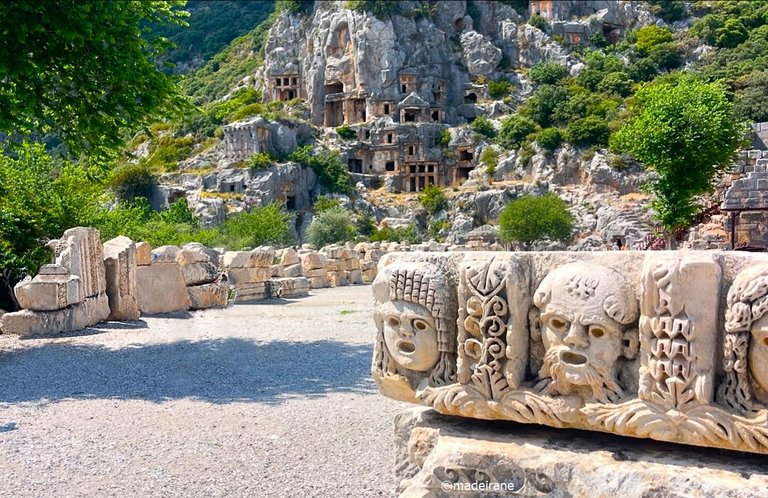
Unfortunately, the tombs are a bit more difficult to study. Tourists are not allowed to enter them, so they can only be viewed from a distance, using a good optical zoom of the camera and your own keen eyesight. By the way, these Lycian tombs are a kind of symbol of this triple excursion. Their image is most often printed on advertising brochures and prospectuses. In general, this can be understood very easily: the buildings are really very unusual, although they cannot be admired up close.
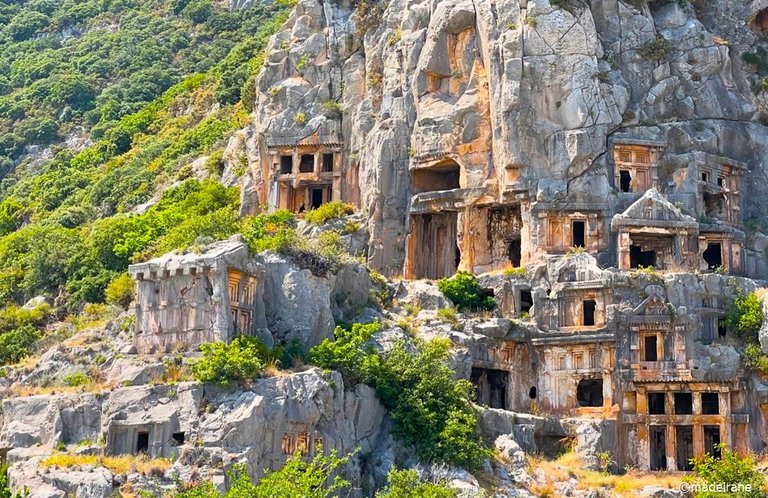
We were told that earlier, once upon a time, rich people arranged their graves on the rocks in this way. Moreover, the higher the crypt was located, the more noble the person was. It was believed that the higher on the mount a person was buried, the faster he would be able to get to heaven. But later the burials were plundered, emptied, and local shepherds, and maybe someone else, stayed in the crypts at night.
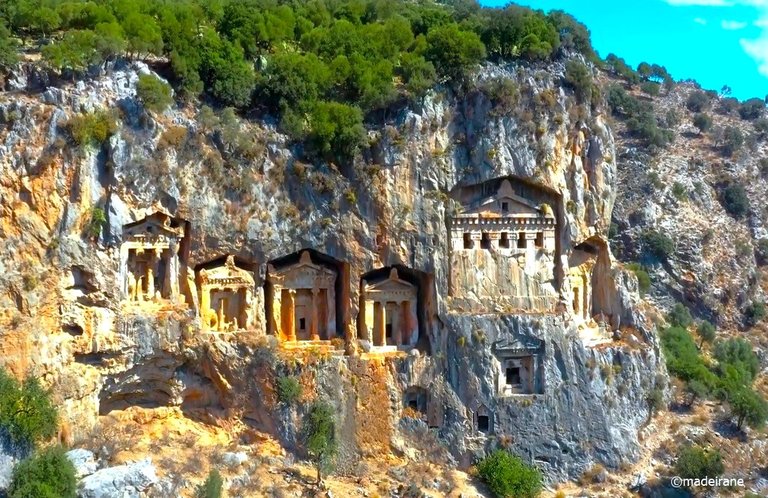
Even from a respectful distance, these monumental structures are very impressive. And they are impressive in a positive way: you can see the painstaking efforts of the ancient masters, with which they cut the stone. At first glance, it seems that the work was not done on site and in the open air, but somewhere in more convenient conditions, using stationary processing devices, and then brought and installed here, on the stone mountain.

Of course, this is not so, and the impression from what you see is even stronger. Just imagine, it was a monolithic rock, from which the excess was systematically chipped off, blow after blow, measured, leveled, polished, burying the work of many months. The masters cursed, gathered their strength and again, under the scorching rays of the sun, did the work, the results of which outlived not only themselves, but also many centuries. Can you imagine?
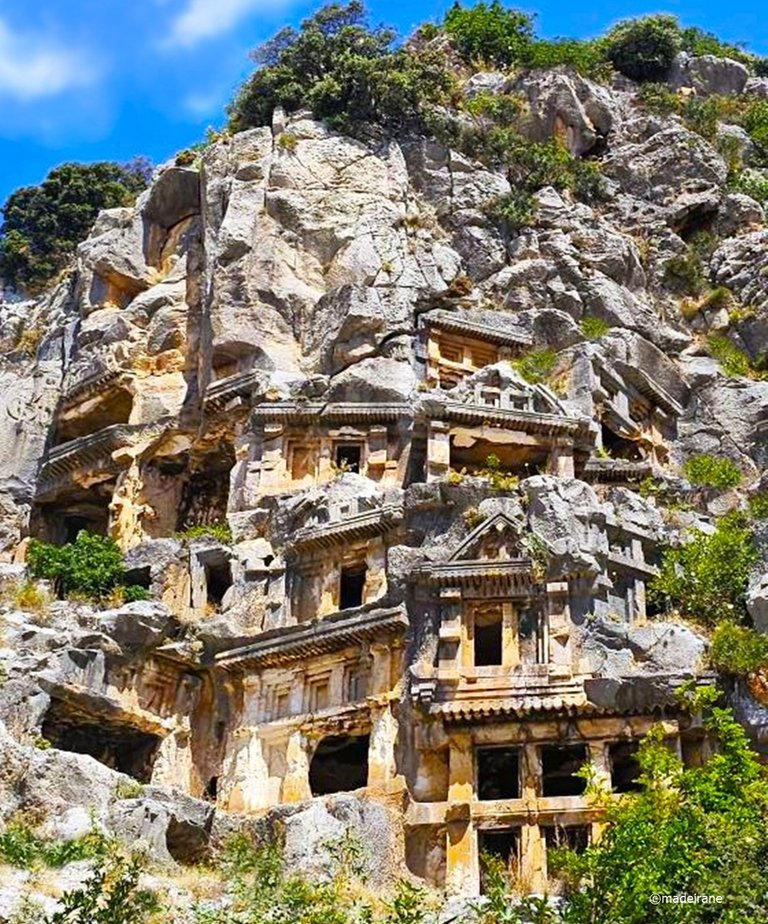
Even now, when the ground level around them has risen, it is difficult to imagine how people got there. Up there, the mountains are almost vertical. But the spectacle is truly unique! It is even difficult to imagine how, without modern technology, people carved such tombs from solid rocks...
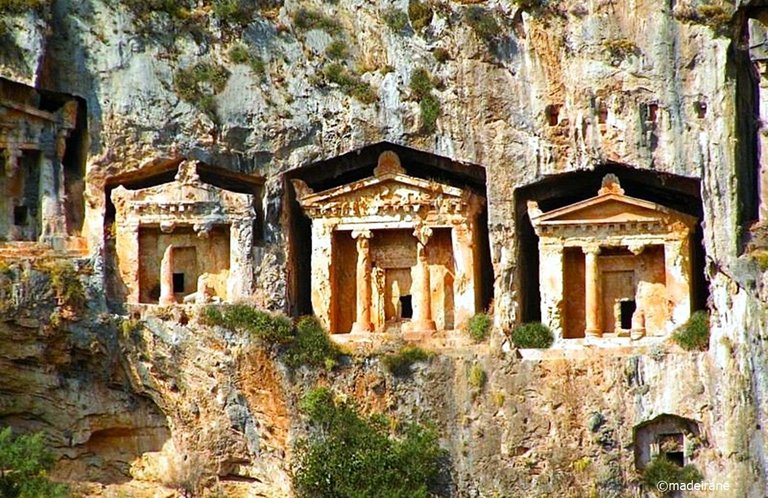
The tomb system is multi-level, and each tier repeats the previous one with barely noticeable differences, usually in some minor details. If you look closely, you can find bas-reliefs with images of people or various symbols, and this is very interesting, because some details, no matter how hard you try, are not visible to everyone who wants to see them. Someone still does not see the outlines of any recognizable images on these gray stones, polished both by people and many centuries.
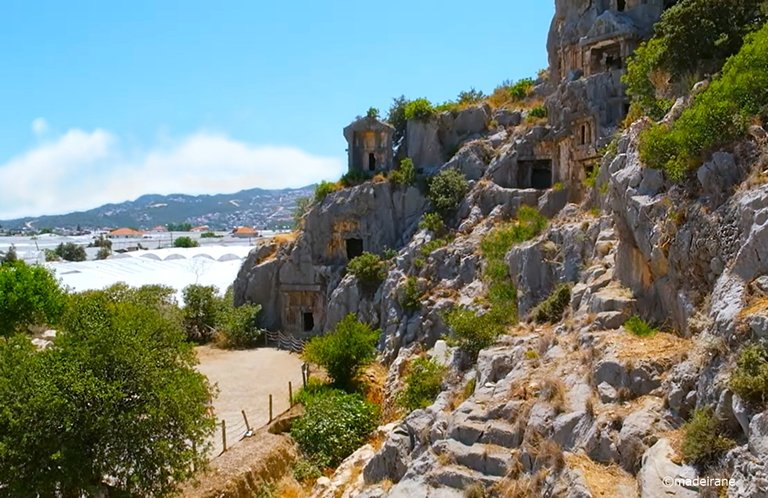
Some of the tombs are roughly destroyed, as if they were hit by a huge battering ram. Some are preserved as if no one has ever touched them over the years. Of course, quite a lot is broken here, but apparently, due to the height and inaccessibility of this place, much has been preserved, so there is something to see.
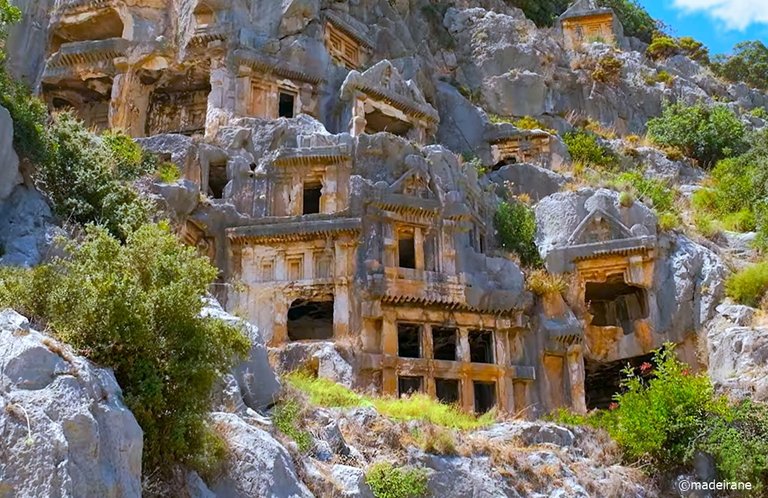
The whole system looks like a huge building with many randomly placed, but beautifully outlined and crafted by a talented hand windows, each of which is the size of a large door. If desired, you can even squeeze through some of these "doors", although the passage is partially closed. Somewhere it is completely open, and somewhere you don't even need to squeeze through - the entrance is free and quite large. True, there is nothing to see inside, there is nothing interesting there.

Some tombs are located right behind the amphitheater, or rather, slightly above its uppermost rows. And some individual tombs seem to have been deliberately made apart, either to the side and separately from the others, or very high above them. Apparently, this was done to emphasize the exclusivity of the persons for whom they were intended.
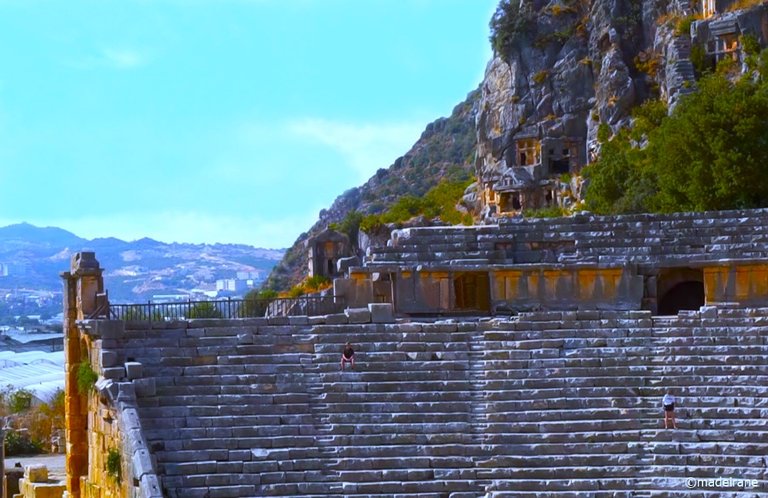
Vegetation is starting to assert its rights little by little, and if nothing is done with it, I think that over time it will cover everything that could be seen. However, growing practically from stone is probably not so easy, and therefore, if this happens, it will be very long.
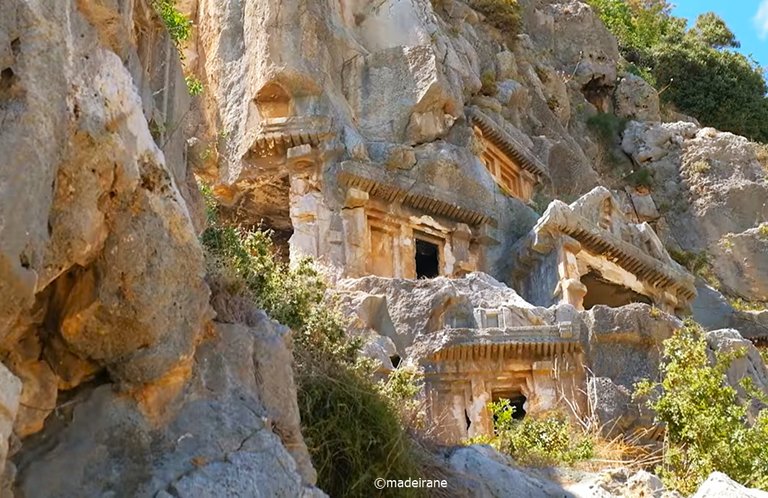
Not all ancient burials here are concentrated in one place. Already leaving from the bus window, I saw tombs, secludedly located on the steep slopes of the mountains. From afar, they can be distinguished only by the square windows cut into solid rock. Seeing such extraordinary human-origin structures with your own eyes is truly impressive and remains in your memory for a long time.
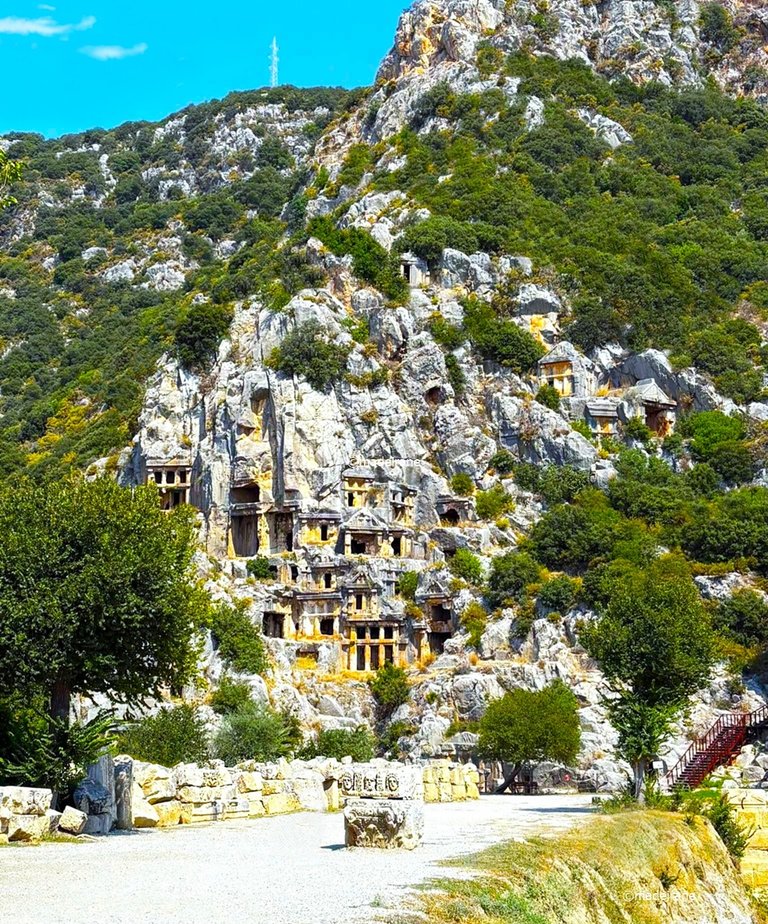
Leaving the city back on the buses, I was in a daze. It was as if I had done something absolutely impossible: I had found a time machine in the middle of the Lycian desert and used it to pierce the thickness of centuries. The past was absolutely real. You could look at it, you could touch it with your hands, you could walk on it with your feet, you could even take a piece of the past with you, but nothing could be changed in it. Time is merciless. Getting on the bus, I literally felt with my whole body how this exciting journey was becoming just history. Another day of my life gone forever, in which nothing could be changed. And I don’t really want to.
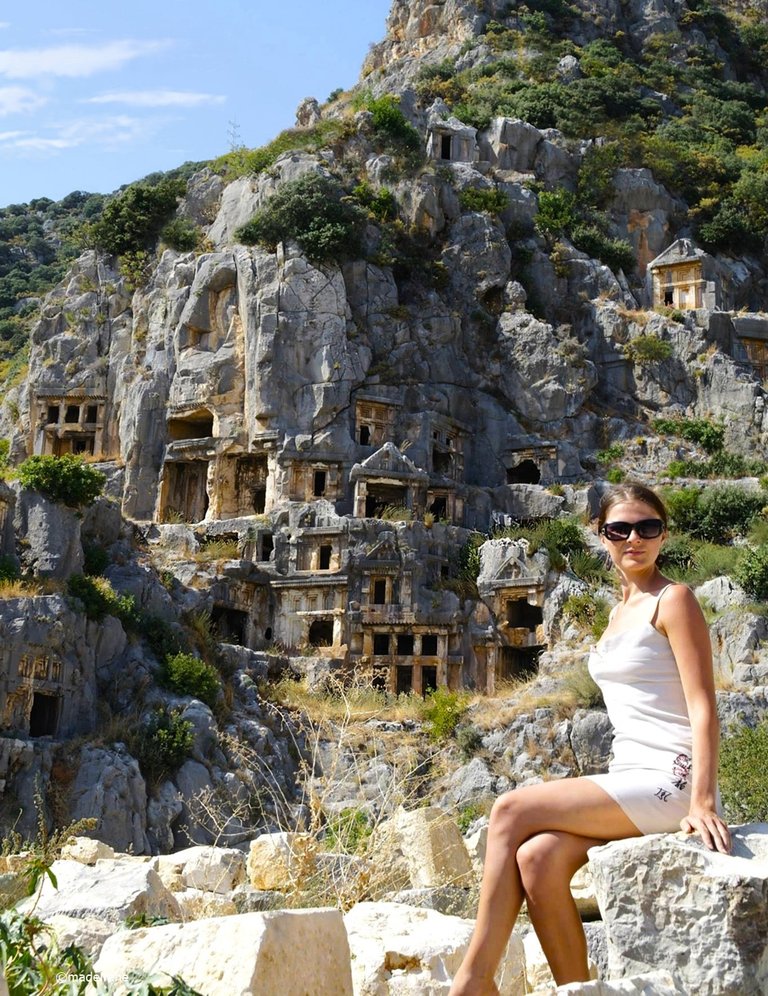
💝💝💝💝💝💝💝💝💝💝
With love, @madeirane
Photos are taken by me.
© 2025
Translated from Lithuanian with DeepL.com (free version)
Dažnai keliaudami aplankome daugybę įvairių vietų, perkame ekskursijas, susipažįstame su vietos įžymybėmis, perkame suvenyrus. Bet ar dažnai tai, už ką sumokame, yra to verta? Kiek laiko šie turistiniai maršrutai ir ryškūs įspūdžiai išlieka mūsų atmintyje? Šiandien norėčiau papasakoti apie vieną vietą, kurios aplankymo vis dar nesigailiu, o prisiminimai apie tai, ką ten mačiau, vis dar yra prieš mano akis. Taigi, tęsiu savo įrašus apie trigubą ekskursiją Demre-Mira-Kekova.
Iš tiesų, senovės mieste Myra yra tik du objektai, kurie verti dėmesio ir dėl kurių čia atvyksta visi. Pirmasis yra amfiteatras, apie kurį jau rašiau, o antrasis tikrai yra kažkas ypatingo! Jis palieka neišdildomą įspūdį. Tai senovės nekropolis, Likijos kapai.
Deja, kapus šiek tiek sunkiau tyrinėti. Turistams į juos įeiti draudžiama, todėl juos galima apžiūrėti tik iš tolo, naudojant gerą fotoaparato optinį priartinimą ir savo aštrią regą. Beje, šie Likijos kapai yra savotiškas šios trigubos ekskursijos simbolis. Jų vaizdas dažniausiai spausdinamas reklaminėse brošiūrose ir prospektuose. Apskritai tai labai lengva suprasti: pastatai tikrai labai neįprasti, nors jais negalima grožėtis iš arti.
Mums buvo pasakota, kad senovėje turtingi žmonės savo kapus įrengdavo ant uolų. Be to, kuo aukščiau buvo kapavietė, tuo kilmingesnis buvo žmogus. Buvo tikima, kad kuo aukščiau ant kalno žmogus buvo palaidotas, tuo greičiau jis pateks į dangų. Vėliau kapai buvo apiplėšti, ištuštinti, o vietiniai piemenys ir galbūt dar kas nors naktimis apsigyveno kapavietėse.
Net iš pagarbaus atstumo šios monumentalios struktūros daro didelį įspūdį. Ir jos įspūdingos teigiamąja prasme: matyti senovės meistrų kruopštus darbas, kuriuo jie iškirto akmenį. Iš pirmo žvilgsnio atrodo, kad darbas nebuvo atliktas vietoje ir po atviru dangumi, bet kažkur patogesnėmis sąlygomis, naudojant stacionarius apdirbimo įrenginius, o tada atgabentas ir sumontuotas čia, ant akmeninio kalno.
Žinoma, taip nėra, ir įspūdis iš to, ką matote, yra dar stipresnis. Tik įsivaizduokite, tai buvo monolitinė uola, iš kurios sistemingai buvo nuskaldoma perteklinė dalis, smūgis po smūgio, matuojama, lyginama, poliruojama, užklojant daugelio mėnesių darbą. Meistrai keikėsi, kaupė jėgas ir vėl, po kaitriais saulės spinduliais, dirbo, o jų darbo rezultatai išliko ne tik ilgiau už juos pačius, bet ir daugelį amžių. Ar galite įsivaizduoti?
Net ir dabar, kai aplink juos pakilo žemės paviršius, sunku įsivaizduoti, kaip žmonės ten pateko. Ten, aukštai, kalnai yra beveik vertikalūs. Bet vaizdas tikrai unikalus! Sunku net įsivaizduoti, kaip be šiuolaikinių technologijų žmonės išskaptavo tokias kapavietes iš kietų uolų...
Kapų sistema yra daugiaaukštė, ir kiekvienas lygis kartojasi su vos pastebimais skirtumais, paprastai tik kai kuriose smulkiose detalėse. Jei atidžiai pažiūrėsite, galite rasti bareljefus su žmonių atvaizdais ar įvairiais simboliais, ir tai labai įdomu, nes kai kurios detalės, kad ir kaip stengtumėtės, nėra matomos visiems, kurie nori jas pamatyti. Kai kurie vis dar nemato jokių atpažįstamų atvaizdų kontūrų ant šių pilkų akmenų, nušlifuotų tiek žmonių, tiek daugelio amžių.
Kai kurios kapavietės yra grubiai sunaikintos, tarsi jas būtų sudaužęs didžiulis taranas. Kai kurios išlikusios taip, tarsi per visus šiuos metus niekas jų nebūtų lietęs. Žinoma, čia yra nemažai sugadintų dalykų, bet, matyt, dėl šio vietos aukščio ir neprieinamumo daug kas išliko, todėl yra ką pamatyti.
Visa sistema atrodo kaip didžiulis pastatas su daugybe atsitiktinai išdėstytų, bet gražiai apibrėžtų ir talentingos rankos sukurtų langų, kurių kiekvienas yra didelių durų dydžio. Jei norite, galite netgi pralįsti pro kai kurias iš šių „durų“, nors praėjimas yra iš dalies uždarytas. Kai kur jis yra visiškai atviras, o kai kur netgi nereikia pralįsti – įėjimas yra laisvas ir gana didelis. Tiesa, viduje nėra nieko įdomaus, ten jau nėra nieko įdomaus.
Kai kurios kapavietės yra tiesiai už amfiteatro, arba, tiksliau, šiek tiek virš jo viršutinių eilių. O kai kurios pavienės kapavietės atrodo sąmoningai padarytos atskirai, arba šone ir atskirai nuo kitų, arba labai aukštai virš jų. Matyt, tai buvo padaryta siekiant pabrėžti tų asmenų, kuriems jos buvo skirtos, išskirtinumą.
Augmenija po truputį pradeda ginti savo teises, ir jei nieko nebus daroma, manau, kad laikui bėgant ji uždengs viską, kas yra matoma. Tačiau augti praktiškai iš akmens tikriausiai nėra taip lengva, todėl, jei tai įvyks, tai užtruks labai ilgai.
Ne visi senovės kapai čia yra sutelkti vienoje vietoje. Jau iš autobuso lango pamačiau kapus, įsikūrusius nuošaliose kalnų šlaituose. Iš tolo juos galima atpažinti tik pagal į kietą uolą iškaltus kvadratinius langus. Pamatyt tokias neįprastas žmogaus sukurtas struktūras savo akimis yra tikrai įspūdinga ir ilgam įsimena.
You can check out this post and your own profile on the map. Be part of the Worldmappin Community and join our Discord Channel to get in touch with other travelers, ask questions or just be updated on our latest features.
Sending Love and Ecency Curation Vote!
 Please Vote for our New Proposal! 🙏
Please Vote for our New Proposal! 🙏
Hello.
To confirm your authorship of the content, could you please add the link to your Hive blog to a profile on a well-established social media account like Facebook, Instagram, or Twitter (which has not been recently created)?
After you add the link, please respond to this comment with the URL link to that website.
You can remove this mention once we confirm the authorship.
Thank you.
More Info: Introducing Identity/Content Verification Reporting & Lookup
https://x.com/madeirane/status/1952056799810523203
Hello.
This Twitter account has never had any activity and does not show a lifestyle of any person.
Also, the last activity was 4 years ago.
To verify, could you please provide a legitimate social media account that shows the lifestyle of the person matching the Hive blog?
Are you serious? First you ask me ton post on social media that was not created recently, and now you ask that I would share my personal life to the whole world. Are you aware that not everyone is posting family photos online? I had Insta account with photos from my life and it was hacked. I never got it back and never will share anything after that. You can do whatever you want with the photos of your life, but not me anymore. At most photos there are my children. I know people from some countries hapuilly show them without fear they can be stollen, but I value my and family's security. I do not use social sites to share my life. At twitter account, there are a lot of my previous works from Bitlanders. I write all my life. I have similar account on FB, old but almost empty too as I don't share my life with strangers. Give me you email and I will send you a few photos from my travels and even with family members faces. But you have to assure me you will delete them after. Thank you.
Thank you for the explanation.
In that case, I will use for verification the social media account that you have provided.